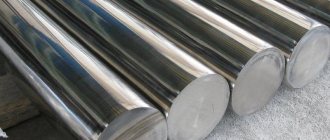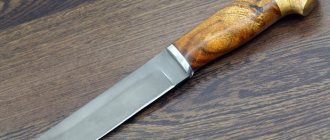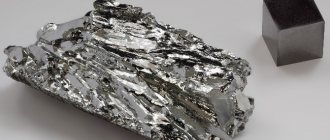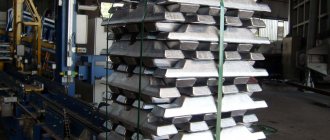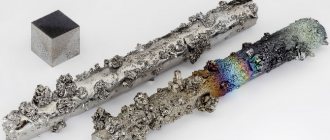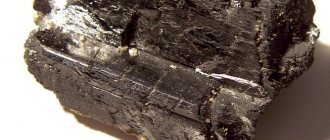| Nickel | |
| Atomic number | 28 |
| Appearance of a simple substance | |
| Properties of the atom | |
| Atomic mass (molar mass) | 58.6934 a. e.m. (/mol) |
| Atomic radius | 124 pm |
| Ionization energy (first electron) | 736.2 (7.63) kJ/mol () |
| Electronic configuration | [Ar] 3d8 4s2 |
| Chemical properties | |
| Covalent radius | 115 |
| Ion radius | (+2e) 69 |
| Electronegativity (Pauling) | 1,91 |
| Electrode potential | -0.25 V |
| Oxidation states | 3, 2, 0 |
| Thermodynamic properties of a simple substance | |
| Density | 8,902 /³ |
| Molar heat capacity | 26.1[1]/(mol) |
| Thermal conductivity | 90,9 /(·) |
| Melting temperature | 1 726 |
| Heat of Melting | 17.61 kJ/mol |
| Boiling temperature | 3 005 |
| Heat of vaporization | 378.6 kJ/mol |
| Molar volume | 6.6 ³/mol |
| Crystal lattice of a simple substance | |
| Lattice structure | cubic face-centered |
| Lattice parameters | 3,524 |
| c/a ratio | — |
| Debye temperature | 375 |
| Ni | 28 |
| 58,6934 | |
| [Ar]3d84s2 | |
| Nickel | |
Nickel
—an element of the side subgroup of the eighth group, the fourth period of the periodic system of chemical elements of D.I. Mendeleev, with atomic number 28. Denoted by the symbol Ni (Niccolum).
The simple substance nickel (CAS number: 7440-02-0) is a ductile, malleable transition metal of a silvery-white color, which at normal temperatures in air is covered with a thin protective film of oxide. Chemically inactive. Schematic of the nickel atom
Nickel was discovered in 1751. However, long before that, Saxon miners were well aware of the ore, which in appearance resembled copper ore and was used in glass making to color glass green. All attempts to obtain copper from this ore were unsuccessful, and therefore at the end of the 17th century. The ore was named Kupfernickel, which roughly means “devil’s ore.” This ore (red nickel pyrite NiAs) was studied by the Swedish mineralogist Kronstedt in 1751. He managed to obtain the green oxide and, by reducing the latter, a new metal called nickel. When Bergman obtained the metal in a purer form, he found that the metal's properties were similar to iron; Nickel has been studied in more detail by many chemists, starting with Proust. Nikkel is a dirty word in the miners' language. It was formed from a corruption of Nicolaus, a generic word that had several meanings. But mainly the word Nicolaus served to characterize two-faced people; in addition, it meant “mischievous little spirit”, “deceptive slacker”, etc. In Russian literature of the early 19th century. the names Nikolan (Scherer, 1808), Nikolan (Zakharov, 1810), nicol and nickel (Dvigubsky, 1824) were used.
Story
The name of the metal is of German origin. This is the name given to the spirit of the mountains in German folklore. He tossed its imitation (nickel) to prospectors looking for copper.
Nickel in German means mischief.
The path to recognition was winding:
- Industrialists discovered the presence of the metal in “kupfernickel” (German for “stubborn” copper) in 1751. Swedish metallurgist August Kronstedt identified the compound as nickel-arsenic.
- Nickel was classified as a "semi-metal".
- 24 years later, Swede Thomas Bergman proved that it was just metal.
- The German chemist Johann Richter obtained pure nickel by reducing nickel sulfate (1804) and gave its scientific description.
Metal has gained international status.
Physico-chemical characteristics
Nickel is resistant to oxidation. This property is provided by a thin surface film of NiO oxide, which appears at ordinary temperatures.
| Properties of the atom | |
| Name, symbol, number | Nickel / Niccolum (Ni), 28 |
| Atomic mass (molar mass) | 58.6934(4) a. e.m. (g/mol) |
| Electronic configuration | [Ar] 3d8 4s2 |
| Atomic radius | 124 pm |
| Chemical properties | |
| Covalent radius | 115 pm |
| Ion radius | (+2e) 69 pm |
| Electronegativity | 1.91 (Pauling scale) |
| Electrode potential | -0.25 V |
| Oxidation states | 0, +2, +3 |
| Ionization energy (first electron) | 736.2 (7.63) kJ/mol (eV) |
| Thermodynamic properties of a simple substance | |
| Density (at normal conditions) | 8.902 g/cm³ |
| Melting temperature | 1726 K (1453 °C, 2647 °F) |
| Boiling temperature | 3005 K (2732 °C, 4949 °F) |
| Ud. heat of fusion | 17.61 kJ/mol |
| Ud. heat of vaporization | 378.6 kJ/mol |
| Molar heat capacity | 26.1 J/(K mol) |
| Molar volume | 6.6 cm³/mol |
| Crystal lattice of a simple substance | |
| Lattice structure | cubic face-centered |
| Lattice parameters | 3.524 Å |
| Debye temperature | 375 K |
| Other characteristics | |
| Thermal conductivity | (300 K) 90.9 W/(m K) |
| CAS number | 7440-02-0 |
The structure centered along the edges determines resistance to loads, and the structural features of the electronic shells of atoms determine the property of magnetization.
Specifics of the structure
A special feature of the mineral is that it belongs to the transition metals. It is also distinguished by its silvery-white hue and low chemical activity.
Researchers were able to identify the following structural features of nickel:
- The presence of a face-centered cubic lattice, the period of which is 0.35238 nm.
- The crystalline structure can withstand pressures of up to 70 GPa.
- Most often, the metal exists in the form of a b-modification with a cubic lattice with a period of 3.5236, and when cathode sputtering in an H2 atmosphere takes the form of an a-modification with a hexagonal lattice. It can transform into cubic when heated.
- The radius of an element's atom is 1.24 a.
- Density - 8.9 g/cm3.
The electronic formula for nickel is as follows: 1s2 2s2 2p6 3s2 3p6 4s2 3d8. The element has 28 electrons, 2 electrons are located on the 1s, 2s, 3s, 4s sublevels, 6 electrons are located on the 2p, 3p and 3d sublevels.
The oxidation state of atoms in compounds is 6, 4, 3, 2, 1, 0, -1. The structure of the nickel atom is a positively charged nucleus, inside of which there are 28 protons and 31 neutrons.
Place of Birth
Nickel is not a rare earth metal - there is enough of it on the planet (0.01% by mass). Found in the earth's crust exclusively in bound form.
It is assumed that the earth's core is composed of its alloy with iron.
The second source of native metal is iron meteorites.
The countries of the Pacific Rim have large deposits:
- Australia;
- Indonesia;
- New Caledonia;
- Philippines.
World reserves of nickel ores amount to millions of tons.
Russian deposits are concentrated in the Urals, in the Voronezh and Murmansk regions, near Norilsk.
Copper-nickel ores occur in zones of deep faults on ancient shields. Their characteristic feature is the constant mineral composition of the ores, including cobalt, platinum group metals, and gold.
Exogenous deposits are three times richer in reserves.
Magnetic properties of nickel
The magnetic properties of nickel are remarkable in many respects. In 1842, J. P. Joule described the increase in length of steel bars when magnetized. After 35 years, physicists reached the chemical cousins of iron - cobalt and nickel. And then it turned out that cobalt rods also elongate in a magnetic field, but this remarkable effect is not found in nickel. A few years later (in 1882) it turned out that nickel not only does not lengthen, but, on the contrary, even shortens in a magnetic field. The phenomenon was called magnetostriction. Its essence lies in the fact that when an external magnetic field is applied, randomly located metal micromagnets (domains) are aligned in one direction, thereby deforming the crystal lattice. The effect is reversible: applying mechanical stress to the metal changes its magnetic characteristics.
Therefore, mechanical vibrations in ferromagnetic materials decay much faster than in non-ferromagnetic materials: the energy of vibrations is spent on changing the state of magnetization. Understanding the nature of this “magnetomechanical damping” has made it possible to create fatigue-resistant alloys for turbine blades and many other parts subject to vibration.
But, perhaps, another area of application of magnetomechanical phenomena is even more important: a nickel rod in an alternating magnetic field of sufficient frequency becomes a source of ultrasound. By swinging such a rod in resonance (for this purpose the appropriate length is selected), an amplitude of oscillations that is colossal for ultrasonic technology is achieved - 0.01% of the length of the rod.
Nickel magnetostrictors were used, among other things, for nickel plating in an ultrasonic field: thanks to ultrasound, extremely dense and shiny coatings are obtained, and the speed of their application can be much higher than without sonication. This is how “nickel helps itself.”
Nickel has been found in iron meteorites. “A mass of native iron weighing 71 Vienna pounds, which fell into the air in front of several eyewitnesses at six o’clock in the afternoon on May 26, 1751, near the village of Grasina in Croatia and was buried three fathoms into the ground in a recently plowed field.”
Ultrasound has many other uses. However, no one seems to have studied the effects of a rapidly varying magnetic field on reactions involving nickel metal: magnetostriction-induced surface pulsation would have a significant effect on the chemical interaction, so studying the reaction of the “sounding” metal may reveal new and unexpected effects.
Methods of extraction and processing
Almost all nickel is obtained from garnierite (green nickel ore) and pyrites.
Mining is carried out using the standard closed (mine) method for most ores.
The extracted raw materials are recovered using three methods:
- Interaction with coal dust in rotary tube kilns. The resulting iron-nickel pellets are removed from sulfur, then calcined and treated with an ammonia solution. The acidified solution is exposed to an electrolyte to produce metal.
- The metal is recovered from oxide ore using an aluminothermic method.
- Carbonyl method. Copper-nickel matte is obtained from the ore, over which CO is released under pressure. The result is tetracarbonylnickel. It is a volatile compound and therefore decomposes when exposed to heat. The metal turns out to be especially pure.
The carbonyl method also appears in the literature as the Mond method.
Alloy classification
The classification of nickel alloys is based on composition and properties.
Acid resistant
Alloys with additive-alloying of other metals:
- Chromium and tungsten give the alloy resistance in aggressive oxidizing environments.
- Compounds with copper or molybdenum are used in aggressive non-oxidizing environments.
Corrosion resistance is provided by silicon and aluminum.
Heat resistant
Alloys such as “nickel + chromium + additives of other alloying elements”. Such elements are aluminum, tungsten, titanium, molybdenum, strontium, and others.
Such metal alloys are in demand for the manufacture of power plant components subject to maximum loads.
Areas of application
The ore, described as copper, was known to Saxon miners in the Middle Ages. It was used as a green pigment for coloring glass.
Since then, thanks to the study of the properties and characteristics of the metal, the scope of application has expanded.
Nickel is one of the best catalyst metals. Other advantages: low activity, resistance to aggressive chemicals, viscosity, plasticity, malleability.
It is used independently and in alloys.
Pure Nickel
Pure nickel is in demand in industrial production:
- Corrosion resistant coating. Used to protect iron, aluminum, magnesium, zinc, cast iron, non-alloy steels. Along the way, it reduces the cost of products.
- Instruments, boilers, crucibles with constant physical and chemical characteristics, resistant to corrosion.
- Tanks for transportation and storage of chemical reagents (including caustic alkalis), essential oils.
- Pipes for pumping alkalis and other aggressive substances at chemical enterprises.
- Toolkit for science, medicine.
- Details of radar, television, remote control of processes at nuclear power plants.
Powdered nickel is used as a catalyst in the production of alcohols, aromatic hydrocarbons, and other compounds. This is a binder for the production of superhard materials, a backfill for filtering gaseous chemical products.
Alloys
More than three thousand compositions of nickel with metals are known:
- The most common ones are with iron, cobalt, chromium, molybdenum, aluminum, titanium, and beryllium.
All stainless steels contain nickel because this metal increases the alloy's chemical resistance.
- Copper-nickel compound monel (nickel - two thirds): chemistry, electrical engineering, medicine. As well as equipment for ocean liners, sea vessels, ports, protective casings of nuclear reactors, gas turbines, jet engines.
- Nickel alloys are tough, with a low coefficient of thermal expansion. They are used to make armor for the needs of the military-industrial complex.
- A special group is copper-based alloys (nickel silver, brass, bronze, others).
- Nickel alloys are the basis of modern coins (for example, a nickel in the USA), windings of strings of musical instruments, and braces.
Products of metallurgical enterprises are supplied in the form of tubes, wires, threads, foil, tape, powder, and other configurations.
Nickel products are in demand where materials are required to be resistant to corrosion in aggressive environments.
The influence of impurities on the properties of the metal
Sulfur is one of the most harmful impurities. It gives nickel red brittleness, due to which the properties of the metal deteriorate during pressure treatment. To neutralize the effect of sulfur, manganese and/or magnesium are added.
Carbon in amounts up to 0.1% does not affect the properties of the metal in any way, however, with a higher content of this element, it falls out of the solid solution during annealing and reduces the ductility of cold nickel.
When the content of bismuth and lead is in an amount of 0.002%, hot metal processing becomes impossible: since these elements are almost insoluble in the solid state, they destroy the ingot. Therefore, in all grades of nickel, the amount of lead and bismuth is limited to 0.001 and 0.0006%, respectively.
Aluminum increases the electrical resistance of nickel. This element is contained in the purest grade - H0. In addition, nickel and aluminum alloys are widely used: they have high heat resistance and corrosion resistance.
Iron does not have a noticeable effect on the properties of nickel. Silicon deoxidizes the base metal, due to which it has a beneficial effect on its casting properties, chemical resistance and strength.
Cobalt increases the heat resistance, heat resistance and strength of nickel, and manganese has a positive effect on the technological and mechanical properties of the metal and improves its electrical resistance.
Cautions
Nickel contains natural and artificially created radioactive isotopes.
This is fraught with health problems at the everyday level:
- This is an allergen, which is taken into account when choosing jewelry, watches, and other products that come into contact with the skin. They can cause contact dermatitis.
- The presence of nickel in the human body reduces blood pressure and provokes vitiligo.
- Excess metal in the soil is the cause of diseases in animals and plants.
- Volatile compounds of the substance are especially dangerous.
Fine nickel powder spontaneously ignites at room temperature.
These disadvantages are not fatal, but they should not be neglected.
Nickel grades and chemical composition
According to GOST 849-2008, 7 grades of nickel are produced - N0, N1Ау, Н1у, Н1, Н2, Н3 and Н4. They contain from 97.6 to 99.99% nickel in total with a small percentage of cobalt (Co) - from 0.005 to 0.7%. The rest of the mass is occupied by impurities:
- Carbon (C) - found in all grades of nickel.
- Magnesium (Mg).
- Aluminum (Al).
- Silicon (Si).
- Phosphorus (P).
- Sulfur (S) - found in all brands.
- Manganese (Mn).
- Iron (Fe).
- Copper (Cu) - found in all brands.
- Zinc (Zn).
- Arsenic (As)
- Cadmium Cd).
- Tin (Sn).
- Antimony (Sb).
- Lead (Pb).
- Bismuth (Bi).
The detailed chemical composition of different grades of nickel is presented in the table below.
| Brand | Chemical composition, % | |||||||||||||||||
| Ni and co, no less | Including Co, no more | Impurities, no more | ||||||||||||||||
| C | Mg | Al | Si | P | S | Mn | Fe | Cu | Zn | As | Cd | Sn | Sb | Pb | Bi | |||
| H0 | 99,99 | 0,005 | 0,005 | 0,001 | 0,001 | 0,001 | 0,001 | 0,001 | 0,001 | 0,002 | 0,001 | 0,0005 | 0,0005 | 0,0003 | 0,0003 | 0,0003 | 0,0003 | 0,0001 |
| H1Ay | 99,95 | 0,1 | 0,001 | 0,001 | — | 0,002 | 0,001 | 0,001 | — | 0,01 | 0,1 | 0,001 | 0,001 | 0,0006 | 0,0005 | 0,0005 | 0,0005 | 0,0001 |
| H1y | 99,95 | 0,1 | 0,01 | 0,001 | — | 0,002 | 0,001 | 0,001 | — | 0,01 | 0,015 | 0,001 | 0,001 | 0,0005 | 0,0005 | 0,0005 | 0,0005 | 0,0003 |
| H1 | 99,93 | 0,1 | 0,01 | 0,001 | — | 0,002 | 0,001 | 0,001 | — | 0,02 | 0,02 | 0,001 | 0,001 | 0,001 | 0,001 | 0,0001 | 0,001 | 0,0006 |
| H2 | 99,8 | 0,15 | 0,02 | — | — | 0,002 | — | 0,003 | — | 0,04 | 0,04 | 0,005 | — | — | — | 0,1 | — | |
| H3 | 98,6 | 0,7 | 0,1 | — | — | — | — | 0,03 | — | — | 0,6 | — | — | — | — | — | — | |
| H4 | 97,6 | 0,7 | 0,15 | — | — | — | — | 0,04 | — | — | 1,0 | — | — | — | — | — | — | |
Prospects
One of the main areas of nickel consumption is alkaline batteries (accumulators). It is being updated in the wake of interest in the production of electric vehicles. Today, the main battery component is cobalt, but it is expensive, and supplies from Africa are problematic. More efficient samples with dominance of lithium and nickel have been developed. It has been established that thanks to nickel, the power of batteries increases. Moreover, its price is six times less than cobalt, and its supply is 20 times higher.
Experts predict an increase in demand for nickel by 2025 to 400,000 tons (from 75,000 tons in 2016).

